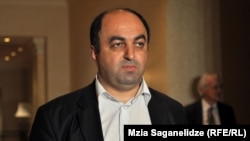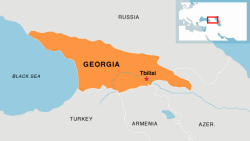Last week marked the first anniversary of what has since been revealed as an abortive covert operation, apparently masterminded by the Georgian Interior Ministry, which resulted in a gunfight that cost the lives of 11 young Chechen fighters, two Georgian Army servicemen, and a military doctor.
Coinciding with the anniversary of this event, the Georgian news portal Primerinfo has published what it says is a translation into Georgian of a letter addressed to one of its journalists from an unnamed Chechen who survived the shoot-out and has since left Georgia.
The Chechen accuses three senior Georgian officials – including former Defense Minister Bacho Akhalaya -- of leading the Chechens into a "trap." But the authenticity of the letter is open to question: the journalist to whom it was addressed, Zviad Mchedlishvili, told RFE/RL’s Georgian Service that he never received it. The Russian original has not yet been posted on any Chechen website.
Immediately after the shoot-out near the village of Lapanquri close to the Georgian-Russian border on August 30, 2012, Georgian officials implied that they had thwarted an attempt by insurgents to enter Georgia from Daghestan.
But an investigation by Georgian human rights ombudsman Ucha Nanuashvili subsequently concluded that the Chechens had been recruited in Europe by Georgian Interior Ministry officials, brought to Tbilisi, and trained over a period of several months in the use of weaponry with the intention of enabling them to cross the border from Georgia into Chechnya to join the ranks of the Islamic insurgency.
In addition to the young Chechens living in exile in Europe, the organizers of the operation also recruited several Kists (Georgian Chechens) from the Chechen community that has lived for several centuries in Georgia's Pankisi Gorge. A group of 20 fighters finally made their way to Lapanquri on August 27, 2012. (Some reports say they commandeered an Interior Ministry vehicle and set off without informing their handlers.)
Two days later (the anonymous Chechen says on August 28), 11 of them, including several Kists, were killed in a gun battle with Georgian special forces after they refused to surrender their arms. The survivors have since left Georgia.
The letter from the unnamed Chechen substantiates Nanuashvili's account of how the young Chechens were recruited, brought to Tbilisi, housed in the city's Saburtalo district and provided with weapons and training. But it differs from Nanuashvili's version in one key respect: the anonymous Chechen claims the recruitment and training was initiated by the Georgian Defense Ministry, not the Interior Ministry, although he also identifies then Deputy Interior Minister Gia Lortkipanidze as one of the three top officials who "led us into a trap." (The third is Sandro Ameridze, head of the regional branch of the Antiterrorism Center.) The Chechen fighter further claims that Bacho Akhalaya, who served as defense minister from 2008 until mid-July 2012, met with the Chechens on a daily basis.
Nanuashvili had identified Lortkipanidze as having coordinated the recruitment and training of the Chechens. Last October, however, a prominent member of the Chechen community in Georgia, Umar Idigov, said that the idea of co-opting Chechens and infiltrating them into Russia was Akhalaya’s.
But in a statement posted in April on his Facebook page, Akhalaya’s brother Dato, himself a former Interior Ministry official, claimed to be in possession of evidence that it was their former boss Vano Merabishvili who masterminded the planned operation. Both Merabishvili and Lortkipanidze have rejected allegations of their involvement as "idiotic" and "absurd."
New Hypotheses
The question thus arises: if the "Chechen letter" is a fake, was its purpose to offload responsibility for the entire operation from Merabishvili onto Akhalaya? Akhalaya was recently acquitted of indictments for exceeding his official powers as well as for illegal confinement and torture, but he remains in custody pending a second trial on similar charges.
In recent months, new hypotheses about why the Chechens were recruited have emerged. Mamuka Areshidze, who heads the Caucasus Institute of Strategic Research, told RFE/RL’s Georgian Service that he thinks the original plan to facilitate the Chechens' infiltration into Russia was changed at some point without their knowledge.
In a recent interview, Nanuashvili referred to allegations that the Chechens were to be mobilized in an attack on Bidzina Ivanishvili, then head of the opposition Georgian Dream coalition, in the run-up to the October parliamentary elections in which Georgian Dream defeated President Mikheil Saakashvili's United National Movement.
But Temur Kenkebashvili, a former member of the Department of Constitutional Security (Georgia’s domestic intelligence agency), denies that any plans existed to target Ivanishvili personally. He told PrimerInfo that what was being mulled was to have the Chechens start a terrorist attack that the authorities would blame on Georgian Dream.
The ongoing official investigation into how, why, and by whom the Chechens were co-opted has apparently stalled, although Ivanishvili, who is now prime minister, said in late April that it would be completed "in the near future."
According to prosecutor Djaba Gurgenidze, the reason for the delay is that the Georgian investigators have not been able to question the surviving Chechen fighters now living abroad.
Given the evidence of Interior Ministry involvement in the operation that Nanuashvili claims to have obtained, it is not clear why the investigation is still being conducted by the Interior Ministry’s Counterintelligence Department, whose personnel took part in the Lapanquri operation, rather than the Prosecutor General. Nanuashvili advocates the creation of a public commission to undertake a separate probe.
Meanwhile, the Russian website kavpolit.com has posted a purported summary of the "Chechen letter" that contains allegations missing from the Georgian-language version posted by PrimerInfo. Specifically, the kavpolit account implicates President Saakashvili in "the death of innocent men."
Coinciding with the anniversary of this event, the Georgian news portal Primerinfo has published what it says is a translation into Georgian of a letter addressed to one of its journalists from an unnamed Chechen who survived the shoot-out and has since left Georgia.
The Chechen accuses three senior Georgian officials – including former Defense Minister Bacho Akhalaya -- of leading the Chechens into a "trap." But the authenticity of the letter is open to question: the journalist to whom it was addressed, Zviad Mchedlishvili, told RFE/RL’s Georgian Service that he never received it. The Russian original has not yet been posted on any Chechen website.
Immediately after the shoot-out near the village of Lapanquri close to the Georgian-Russian border on August 30, 2012, Georgian officials implied that they had thwarted an attempt by insurgents to enter Georgia from Daghestan.
But an investigation by Georgian human rights ombudsman Ucha Nanuashvili subsequently concluded that the Chechens had been recruited in Europe by Georgian Interior Ministry officials, brought to Tbilisi, and trained over a period of several months in the use of weaponry with the intention of enabling them to cross the border from Georgia into Chechnya to join the ranks of the Islamic insurgency.
In addition to the young Chechens living in exile in Europe, the organizers of the operation also recruited several Kists (Georgian Chechens) from the Chechen community that has lived for several centuries in Georgia's Pankisi Gorge. A group of 20 fighters finally made their way to Lapanquri on August 27, 2012. (Some reports say they commandeered an Interior Ministry vehicle and set off without informing their handlers.)
Two days later (the anonymous Chechen says on August 28), 11 of them, including several Kists, were killed in a gun battle with Georgian special forces after they refused to surrender their arms. The survivors have since left Georgia.
The letter from the unnamed Chechen substantiates Nanuashvili's account of how the young Chechens were recruited, brought to Tbilisi, housed in the city's Saburtalo district and provided with weapons and training. But it differs from Nanuashvili's version in one key respect: the anonymous Chechen claims the recruitment and training was initiated by the Georgian Defense Ministry, not the Interior Ministry, although he also identifies then Deputy Interior Minister Gia Lortkipanidze as one of the three top officials who "led us into a trap." (The third is Sandro Ameridze, head of the regional branch of the Antiterrorism Center.) The Chechen fighter further claims that Bacho Akhalaya, who served as defense minister from 2008 until mid-July 2012, met with the Chechens on a daily basis.
Nanuashvili had identified Lortkipanidze as having coordinated the recruitment and training of the Chechens. Last October, however, a prominent member of the Chechen community in Georgia, Umar Idigov, said that the idea of co-opting Chechens and infiltrating them into Russia was Akhalaya’s.
But in a statement posted in April on his Facebook page, Akhalaya’s brother Dato, himself a former Interior Ministry official, claimed to be in possession of evidence that it was their former boss Vano Merabishvili who masterminded the planned operation. Both Merabishvili and Lortkipanidze have rejected allegations of their involvement as "idiotic" and "absurd."
New Hypotheses
The question thus arises: if the "Chechen letter" is a fake, was its purpose to offload responsibility for the entire operation from Merabishvili onto Akhalaya? Akhalaya was recently acquitted of indictments for exceeding his official powers as well as for illegal confinement and torture, but he remains in custody pending a second trial on similar charges.
In recent months, new hypotheses about why the Chechens were recruited have emerged. Mamuka Areshidze, who heads the Caucasus Institute of Strategic Research, told RFE/RL’s Georgian Service that he thinks the original plan to facilitate the Chechens' infiltration into Russia was changed at some point without their knowledge.
In a recent interview, Nanuashvili referred to allegations that the Chechens were to be mobilized in an attack on Bidzina Ivanishvili, then head of the opposition Georgian Dream coalition, in the run-up to the October parliamentary elections in which Georgian Dream defeated President Mikheil Saakashvili's United National Movement.
But Temur Kenkebashvili, a former member of the Department of Constitutional Security (Georgia’s domestic intelligence agency), denies that any plans existed to target Ivanishvili personally. He told PrimerInfo that what was being mulled was to have the Chechens start a terrorist attack that the authorities would blame on Georgian Dream.
The ongoing official investigation into how, why, and by whom the Chechens were co-opted has apparently stalled, although Ivanishvili, who is now prime minister, said in late April that it would be completed "in the near future."
According to prosecutor Djaba Gurgenidze, the reason for the delay is that the Georgian investigators have not been able to question the surviving Chechen fighters now living abroad.
Given the evidence of Interior Ministry involvement in the operation that Nanuashvili claims to have obtained, it is not clear why the investigation is still being conducted by the Interior Ministry’s Counterintelligence Department, whose personnel took part in the Lapanquri operation, rather than the Prosecutor General. Nanuashvili advocates the creation of a public commission to undertake a separate probe.
Meanwhile, the Russian website kavpolit.com has posted a purported summary of the "Chechen letter" that contains allegations missing from the Georgian-language version posted by PrimerInfo. Specifically, the kavpolit account implicates President Saakashvili in "the death of innocent men."









